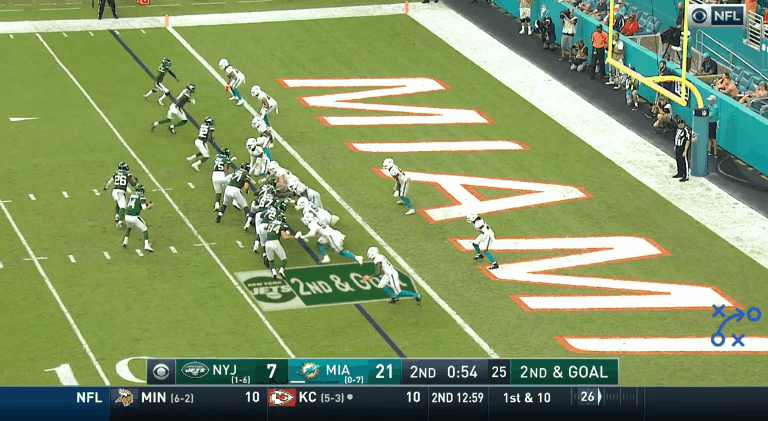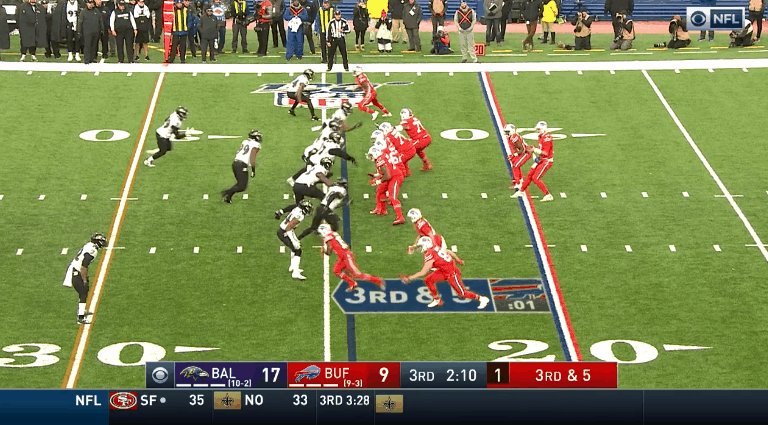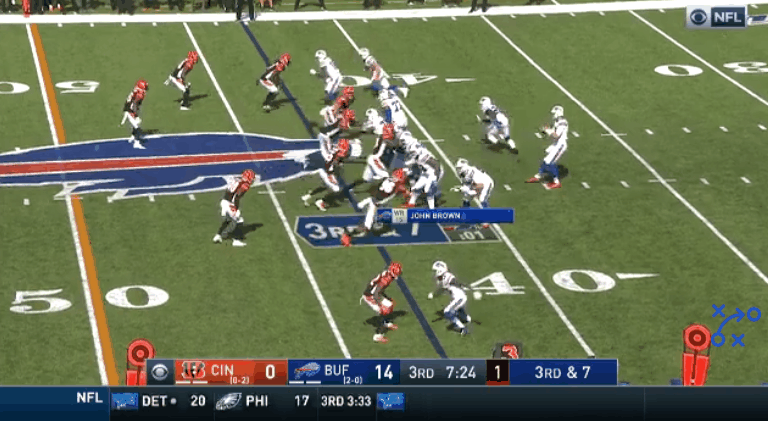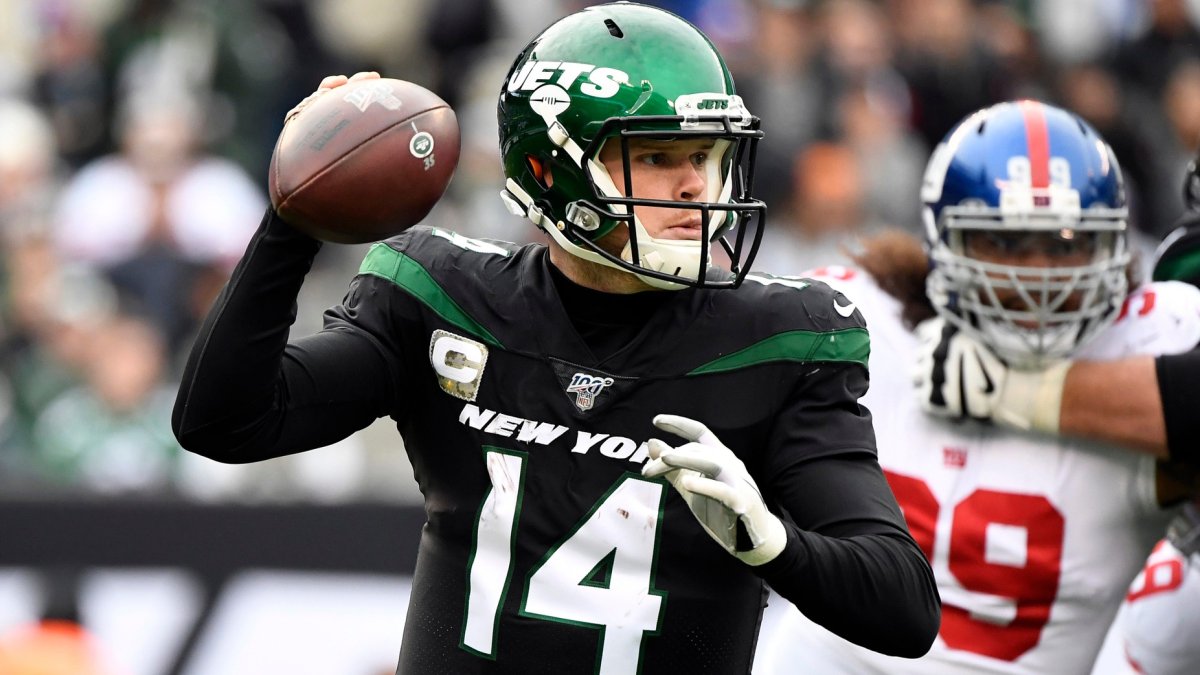It should come as no surprise that quarterback performance improves significantly when there aren’t defenders breathing down signal-callers' necks. Last season, the average passer rating from a clean pocket was 97.3 compared to just 63.5 when pressured.
On a broader scale, teams averaged 4 more yards per dropback without pressure (7.6) than on dropbacks with pressure (3.6). While all quarterbacks see a hit to their production under pressure, some handle it better — and have to do so less frequently — than others. Using the difference in clean-pocket passing grade and pressured passing grade along with the percentage of plays a quarterback was pressured, these are the 10 projected 2020 starters who were affected the most by pressure last season.
[Editor’s Note: PFF’s advanced statistics and player grades are powered by AWS machine learning capabilities.]
1. Sam Darnold, New York Jets
2019 numbers: -50.2 difference in PFF passing grade when pressured, 42% pressure rate
Seeing ghosts wasn’t a one-game occurrence for Darnold last season. No quarterback was pressured on a higher percentage of his dropbacks than the Jets' signal-caller, and the only qualifying quarterback to see a larger gap in their clean pocket and pressured passing grades was Joe Flacco.

There are some really questionable decisions on Darnold’s tape when the defense does get in his face — none more so than this play at the end of the first half in the Jets' Week 9 contest with the Miami Dolphins. Darnold just has to take the sack or throw the ball away, not launch a prayer into a crowd of players. The additions that the Jets made to the offensive line in both the 2020 NFL Draft and free agency give a chance for improved pass protection, but the question becomes by how much. The Jets still rank just 27th in PFF’s offensive line rankings heading into next season. The pressure isn’t going to disappear overnight. Darnold is going to have to do a better job of dealing with it when it comes.
2. Matt Ryan, Atlanta Falcons
-48.0 difference in PFF passing grade when pressured, 39% pressure rate
The 2019 campaign was rough for Ryan and the Falcons, and a lot of it had to do with troubles along the offensive line. The Falcons attempted to bolster the group up front with the addition of not one but two first-round offensive linemen — Chris Lindstrom at right guard and Kaleb McGary at right tackle — but it wasn’t smooth sailing for the rookies.
Lindstrom showed some promise, but he played in only five games all season due to injury. McGary, on the other hand, struggled mightily in his first season of action. He was the only tackle in the NFL to allow double-digit sacks and quarterback hits. Meanwhile, Ryan had a top-five passing grade in the NFL from a clean pocket in 2019.
3. Ryan Fitzpatrick, Miami Dolphins
-44.4 difference in PFF passing grade when pressured, 40% pressure rate
Fitzpatrick has been one of the best quarterbacks in the NFL over the past two seasons from a clean pocket. His 92.9 passing grade from a clean pocket since 2018 ranks fourth in the NFL — behind Russell Wilson, Drew Brees and Patrick Mahomes. The only issue is that Fitzpatrick was pressured at one of the highest rates in the NFL last season, and the pressure was getting there fast.
| Team | Pressure rate allowed in 2.5s or less |
| Miami Dolphins | 33% |
| New York Jets | 27% |
| Seattle Seahawks | 27% |
| Atlanta Falcons | 26% |
| Detroit Lions | 25% |
The Dolphins’ offense allowed pressure in 2.5 seconds or less on one-third of its dropbacks in 2019 — six percentage points more than the next closest NFL team. It’s tough for a quarterback to have success when the pressure gets there that quickly. The Dolphins certainly put a lot of resources into the group up front, but it’s still not a strong unit on paper in its first season together. It’s one of the reasons that Fitzpatrick (and not Tua Tagovailoa) seems likely to start the season at quarterback.
4. Matthew Stafford, Detroit Lions
-44.7 difference in PFF passing grade when pressured, 38% pressure rate
Stafford got off to a tremendous start last season. His 81.6 PFF passing grade through nine weeks ranked seventh in the NFL, and he was pushing the ball downfield with success. His 8.2% big-time throw rate — a category that contains accurate downfield passes and tight-window throws — was second among quarterbacks. A lot of that success could be attributed to what he was doing from a clean pocket, though.
His play under pressure wasn’t nearly as impressive, but he did do a decent job of limiting both turnovers (0 interceptions under pressure) and sacks (18 on 120 dropbacks) when pressured. A downfield passing game is going to come with longer-developing routes, giving the defense more time to get to the quarterback. If the Lions can hold up against that pressure in 2020, Stafford could have a strong case for Comeback Player of the Year.
5. Kirk Cousins, Minnesota Vikings
-42.4 difference in PFF passing grade when pressured, 36% pressure rate
It is no secret that the Vikings have had their fair share of struggles along the offensive line. Their plan to circumvent that last season was a heavy dose of play action and plays that got Cousins outside of the pocket on designed rollouts. Cousins had some success with that gameplan, but pressure still caused him trouble. His clean-pocket passing grade was tied for first in the NFL with Russell Wilson and Ryan Tannehill among qualifying quarterbacks, but his pressured passing grade of 51.0 ranked 16th among 32 qualifying quarterbacks.
It fits the current narrative surrounding Cousins. When things are going well, he looks good. When they’re not, you don’t have a whole lot of confidence in him rising above the poor situation.
6. Josh Allen, Buffalo Bills
-41.5 difference in PFF passing grade when pressured, 36% pressure rate
Allen’s arm gives him the ability to make some spectacular throws when on the move, as he shows in this incompletion to Cole Beasley down the sideline.

It also leads to plays where he trusts his arm a little too much, resulting in plays like the one below.

Allen admittedly plays a fun-to-watch brand of football. His high end of play is remarkable given his combination of arm strength and athleticism. The problem is that the low end shows up much more often than the high end, and his down-to-down accuracy just isn’t there. Allen can make a wider variety of throws than most NFL quarterbacks, but that doesn’t mean he has to force the issue on each attempt and invite pressure on himself by holding on to the ball.
7. Gardner Minshew, Jacksonville Jaguars
-40.9 difference in PFF passing grade when pressured, 35% pressure rate
If you had said Minshew would be PFF’s highest-graded rookie quarterback after the 2019 NFL season, not too many people would have believed you. His play under pressure wasn’t one of the big reasons why, though. If you want to simply use touchdown-to-interception ratio under pressure (which is a bad idea), Minshew’s 10 touchdowns to two interceptions would be one of the better marks in the NFL. That doesn’t capture the fact that he completed just 42% of his passes (29th in NFL among 32 quarterbacks) and averaged only 5.3 yards per pass attempt (25th).
His 42.7 PFF passing grade under pressure (24th) aligns more closely with those numbers than it does the touchdown-to-interception ratio. He’s getting another opportunity to start in 2020, and for him to keep that job from prospective draft picks or free agents in 2021, Minshew will need to continue to improve.
8. Deshaun Watson, Houston Texans
-36.6 difference in PFF passing grade when pressured, 38% pressure rate
Watson is the poster boy for quarterbacks who invite pressure on themselves. The Texans’ offensive line was actually much improved in pass protection during the 2019 season, but Watson tied for the league lead in pressures attributed directly to the quarterback for holding onto the football too long.
| Player | Pressures responsible for |
| Deshaun Watson | 44 |
| Jacoby Brissett | 44 |
| Kyler Murray | 42 |
| Jameis Winston | 35 |
| Russell Wilson | 35 |
That is a big contributing factor to the 38% pressure rate that ranked as one of the highest marks in the NFL. The best way to combat the effects of pressure on Watson is to involve the quick passing game a little bit more.
A reduction in time to throw is something that we’ve seen implemented with quarterbacks like Ben Roethlisberger and Andrew Luck (right before he retired). It will be interesting to see how long the Texans allow Watson to freelance in the pocket to make plays — continuing to rack up sacks and hits in the process.
9. Jimmy Garoppolo, San Francisco 49ers
-45.8 difference in PFF passing grade when pressured, 30% pressure rate
Garoppolo is the first of two quarterbacks to end this list who saw massive splits when kept clean compared to when under pressure, yet faced pressure at one of the lowest rates in the NFL. A time to throw of 2.58 seconds (fourth-lowest in the NFL) had something to do with that. The problem for Garoppolo wasn’t necessarily efficiency when pressure did get home; it was the big mistakes he made.
His 7.3 yards per pressured pass attempt ranked seventh among all quarterbacks, but his 12 turnover-worthy plays on only 174 pressured dropbacks ranked in the bottom 10 in the NFL. Cleaning up some of those mistakes is the next step in his progression as the team’s franchise quarterback.
10. Ryan Tannehill, Tennessee Titans
-40.8 difference in PFF passing grade when pressured, 30% pressure rate
Tannehill’s 2019 season came out of nowhere. He went from the worst quarterback in the NFL by PFF grade in 2018 to one of the best, supported by a Titans’ offensive scheme that put him in good situations. The 30% pressure rate on his dropbacks points to that, aided by a solid offensive line and frequent play-action usage that slowed opposing pass rushes. Tannehill took full advantage of clean pockets, generating a 93.4 passing grade that tied Wilson and Cousins for first in the league.
His performance under pressure wasn’t nearly as impressive, and a lot of that had to do with a high sack rate. After Tannehill took over in Week 7, Tennessee ranked just 19th in yards per pressured pass play (3.1) compared to first by 0.5 yards from a clean pocket (7.1). It’s hard not to expect some regression from Tannehill in 2020.



 © 2025 PFF - all rights reserved.
© 2025 PFF - all rights reserved.